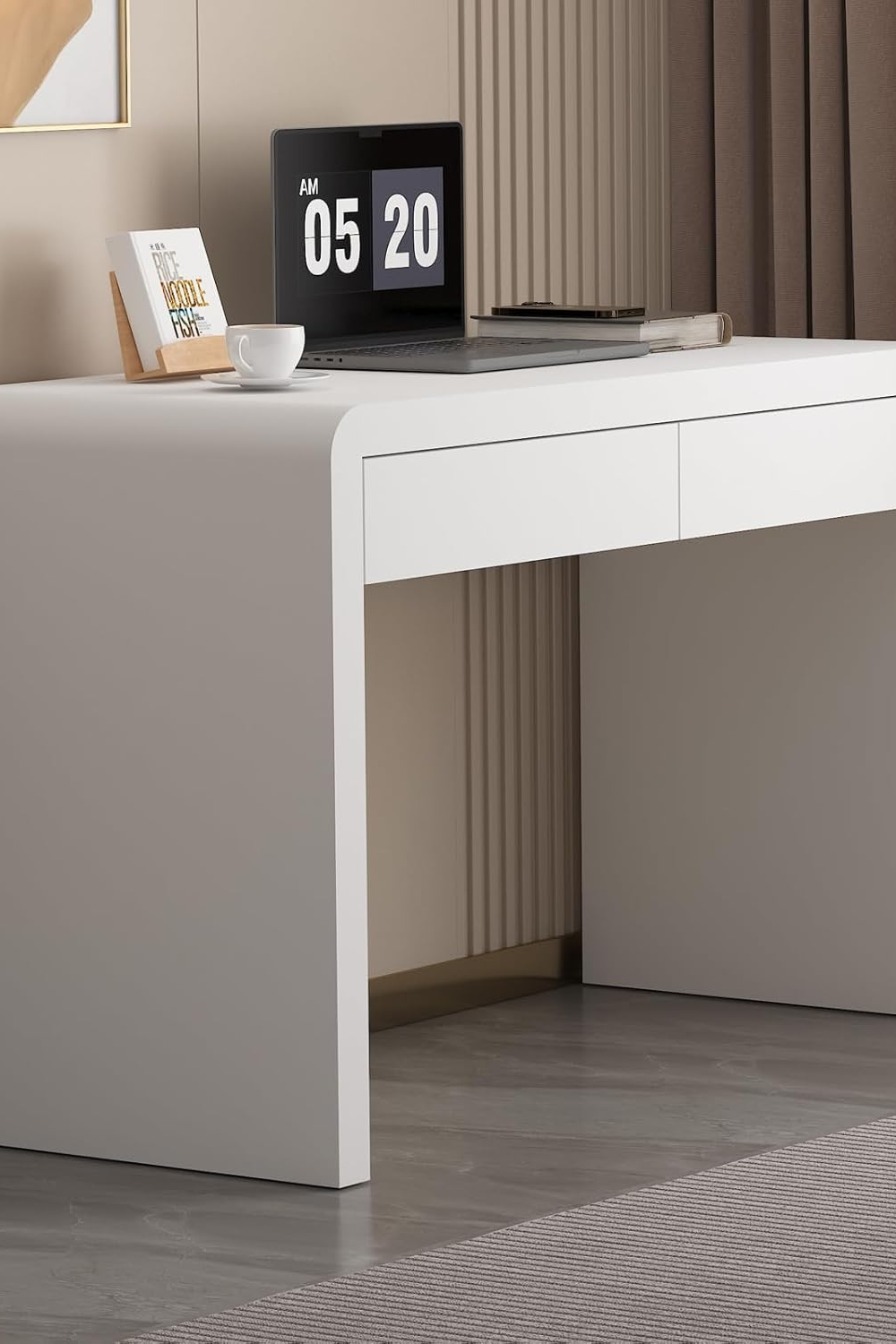Best therapy desks for a grounded, beautiful practice space
Being a therapist means holding space for others—through long days, deep emotional work, and everything in between. But who holds space for you?
Your desk isn’t just a place to sit. It’s where you plan sessions, write notes, pause between clients, and reconnect with yourself. When you work in a space that feels cluttered, cramped, or uninspired, it’s hard to stay present. But when you curate a space that’s beautiful, functional, and calming, it changes everything.
In case you’re new here, I’m Natalia, a website designer for therapists, and I help private practice owners like you amplify their magic, gain visibility, and simplify their marketing efforts through strategic web design and SEO content. And just like your website, your desk is part of your presence—it sets the tone for how you show up.
Let’s explore how your therapy desk can become a foundation of clarity, creativity, and care—and a curated list of desks to help you find the one that supports you best.
Why your therapy desk matters more than you think
Your desk isn’t just where you work—it’s where you land. When your days are filled with emotional labor, your space becomes part of your regulation. A beautiful, well-organized desk doesn’t just make things look nice—it supports your nervous system.
How your desk affects your presence
When your workspace is calm, clean, and thoughtfully arranged, it helps you:
- Settle between sessions
- Think more clearly
- Feel emotionally grounded
A beautiful desk becomes a visual anchor. It helps you transition between your roles: therapist, note-taker, business owner, human.
Beauty and function aren’t luxuries
Many therapists feel guilty investing in aesthetics—but a workspace that feels nourishing is not indulgent. It’s necessary. A visually pleasing, organized desk reminds you that your comfort matters too. It says: This space is for me.
What to consider when choosing a therapist desk
There’s no one-size-fits-all desk—but there is a desk that fits you.
Think about your body
If you’re sitting for multiple sessions a day, your desk should:
- Be the right height (or adjustable)
- Support healthy posture
- Pair well with an ergonomic chair
Consider standing desks or desks with adjustable heights if you like to move between positions throughout the day.
Think about your space
Do you have a large office? A corner in your living room? A shared home setup?
- For small spaces, look for desks with a minimal footprint and smart storage.
- For full offices, choose something that makes the space feel inviting and warm.
Think about your energy
Do you feel calm when you sit down at your desk? Do you feel focused? Spacious? If not, your desk may be contributing to mental fog or overstimulation. Look for clean lines, neutral tones, or natural textures that support clarity and calm.
Top 10 desks for your therapy office
Here are therapist-approved desks that combine beauty, comfort, and functionality—each one linking to Amazon with a “buy now →” so you can explore further.
1. Electric Adjustable Desk with Storage
A modern, height-adjustable desk perfect for therapists who like to alternate between sitting and standing.
- Sleek design with hidden storage
- Supports body comfort and energy shifts
- Great for creating a flexible, modern workspace

2. JXQTLINGMU Desk with Built-In Storage
Elegant and functional with ample storage for files, tools, and personal items.
- Beautiful wood tone
- Great for keeping your space tidy and professional
- Ideal for private offices or home therapy rooms

3. Polycarbonate Modern Writing Desk
Lightweight, minimalist, and perfect for clean aesthetics.
- A great budget option
- Transparent and sleek, fits small spaces
- Best for therapists who value simplicity

4. Mopio Norwin Industrial Desk
Stylish yet sturdy, this desk blends industrial charm with clean design.
- Great for grounding energy
- Works beautifully in both modern and rustic spaces
- Compact yet impactful

5. ModernMate Desk with File Cabinet
High-end look with privacy features and built-in cabinet.
- Ideal for therapists who also do admin work at their desk
- Offers a professional, elevated aesthetic

6. Minimalist Writing Desk for Small Spaces
Perfect for cozy home offices that still need to feel professional.
- Simple wood finish
- Clean lines that create visual calm
- Great for transitional spaces

7. Compact Desk with Drawers
This desk offers practical storage with a small footprint.
- Best for multitaskers with limited room
- Helps you stay organized without clutter

8. Ultra-Minimalist Modern Wood Desk
A therapist favorite for clean energy and beautiful simplicity.
- No fuss, just function and flow
- Matches any calm, neutral therapy space

9. Executive Style Desk with Built-In Shelf
Offers visual presence and a feeling of leadership.
- Adds structure to your office
- Best for therapists building group practices or supervision spaces

10. Small-Form Executive Desk
Sleek, functional, and elegant. A great blend of beauty and practicality.
- Fits small rooms but still feels elevated
- Great for coaches or hybrid therapists who do multiple kinds of work

A beautiful desk can change how you feel about your work
Your desk isn’t just for your laptop and your planner. It’s where your nervous system lands between sessions. It’s where you sip tea, review notes, and find your center again.
Why beauty is part of the job
Therapists spend so much time focused on helping others—it’s easy to overlook your own environment. But a desk that feels beautiful and aligned with your style helps you:
- Feel more connected to your work
- Stay grounded in stressful moments
- Enjoy your space (even when the day is full)
Visual calm supports mental clarity. A space that feels good helps you do good work.
Working from home? Here’s how to make your space feel sacred
When your therapy desk is also your kitchen table, it’s even more important to create small rituals that bring focus and separation.
Ideas to help you transition in and out of work mode:
- Light a candle or diffuser when starting your workday
- Use a soft desk lamp instead of overhead light
- Keep a small box or basket with your therapy essentials you can unpack at the start and store when done
These actions create a cue to your body and mind: this is work time.
And when the session ends? Another cue: this is rest.
Even the smallest space can become sacred with intention.
Your desk holds you while you hold others
Being a therapist is intimate, emotional, and often exhausting work. Your space matters.
A good desk is more than furniture—it’s part of your self-regulation system. A clean, grounding, beautiful desk doesn’t just make your office look good—it helps you feel good.
And if your digital space could use the same support—
I help therapists build brands and websites that feel as clear, rooted, and resonant as the work you do. Because your online presence is just another extension of the space you hold.
✨ Explore my services here and let’s make your whole presence—online and off—feel like home.

* AI Disclosure: This content may contain sections generated with AI with the purpose of providing you with condensed helpful and relevant content, however all personal opinions are 100% human made as well as the blog post structure, outline and key takeaways.
* Affiliate Disclosure: Some of the links on www.nataliamaganda.com may contain affiliate links meaning that I will get a commission for recommending products at no extra cost to you.

hello! i'm natalia
Latina, web design expert for mental health professionals.
I help ambitious life coaches, therapists and holistic leaders amplify their magic, gain visibility, and simplify their marketing efforts through strategic web design and content.










